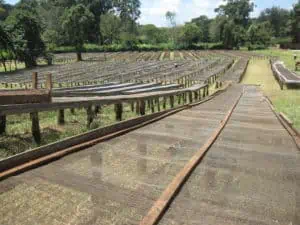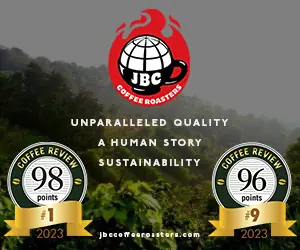The Coffee Paradox, by Benoit Daviron and Stefano Ponte (Zed Books, 2005) analyzes at length the disturbing trend that, just as coffee has grown fashionable and retail prices for coffee have increased in regions where coffee is consumed, like North America, Europe and East Asia, the basic prices paid to growers for their green coffees have decreased, rather radically. In 1997 the composite price for an unroasted Arabica coffee in the mild commodity category, meaning a cleanly processed, good quality coffee, was $1.89 per pound. In 2017, 20 years later, the composite price for the same category of good-quality unroasted Arabica coffee was $1.59 per pound. If we apply an average global inflation rate of 3% per year to that original composite price of $1.89 achieved 20 years ago, coffee growers supplying the same quality of coffee in 2017 should have received an inflation-adjusted price of $3.41 per pound.
They did not. Instead they got less for their coffee than they did 20 years ago, considerably less. The benchmark C-contract price at the moment I write is a fraction over one dollar per pound. And that is for a clean, wet-processed, high-grown Arabica coffee. That is a grotesque price. It does not even come close to covering a farmer’s cost of production.

Green coffee on offer at the Kariru factory in Kenya. Courtesy of Corvus Coffee Roasters.
And remember that coffee is not an industrialized commodity crop that can leverage productivity gains through technology to offset reduced or stagnated prices. Coffee remains a hands-on artisan crop produced mostly on medium-sized to tiny family-owned farms, with the only significant exception some large industrialized farms in Brazil.
Perhaps such figures would not be shocking were coffee some forgotten niche product. But as we know, coffee in consuming countries has never been so celebrated, so glamorous. Small new roasting companies pop up everywhere in the U.S.; many of them prosper; Starbucks grows; regular consumers switch from canned coffees to expensive Keurig or Nespresso pods. So just at the historical moment that coffee farmers in inflation-adjusted terms get paid much, much less for their coffees, the retail side of specialty coffee explodes with higher prices for more and more differentiated products. Overall, the value added goes largely to roasters and retailers in consuming countries.
A Cooperative in Kenya
This discrepancy applies even to some of the finest specialty coffees. I recall touring a coffee cooperative in central Kenya some years ago with a small group of coffee roasters and importers. We visited a meeting of the cooperative members, about 100 or so small-holding farmers, and at one point we were asked whether any of us had anything we wanted to say to the co-op members. One visitor, the owner of a small, high-end boutique coffee roasting company in Paris, announced that he did have something to say. He eagerly and proudly announced that he was selling coffee produced by this very cooperative (it is one of many Kenya cooperatives particularly admired for the quality and distinction of its coffees) in his shop in Paris at an extremely high price, and that, despite this very high price, upscale shoppers in his neighborhood were snapping it up.
I don’t recall the exact price he quoted, but let’s say it was about the equivalent of US$40 per pound. It definitely was an outrageous price at the time. This roaster’s intent, of course, was to impress the cooperative members with news of how well their coffee was received in his country, even to the point of commanding astonishingly high prices. He wanted to congratulate them and offer them proof of their success.

African beds used for drying coffee in Kenya. Courtesy of Kenneth Davids.
However, this news was greeted with a long silence from the co-op members. Finally, one raised his hand, stood up, and asked: Well, if my coffee gets US$40 per pound in Paris, then why do I only get US$3 per pound when I sell it here
The figures I quote may be fuzzily remembered, but the gist of the exchange is very clearly remembered. And even though the best Kenya green coffee commands quite high prices by coffee world standards, the idea that one of the world’s greatest coffees, a coffee equivalent in distinction to wines that sell for as much as several hundred dollars a bottle, should earn the producers US$3 or so per pound is shocking and depressing to any of us who love fine coffee and respect hard work and dedicated artisanry.
And farmers who sell very good though not exceptional coffees fare even worse.
Exceptions to the Paradox
One solution, as Daviron and Ponte propose in The Coffee Paradox, is getting some of the value added for coffee into the hands of producers rather than almost entirely in the hands of roasters and retailers.
In part, the world of fine coffee as we survey it at Coffee Review, with its small lots of exceptional coffees branded at origin by farm, mill or cooperative and sold at a significant premium to aficionado consumers by roasters who function more as commercial partners than commodity exploiters, is one way of transferring some of the value added to those who actually produce these exceptional coffees. The fashionable term for this practice as I write is direct trade, and there are caveats and quibbles aplenty about how direct trade is — and should be — conducted, but nevertheless, it clearly has resulted in significantly more recognition and higher prices for producers able to take advantage of it.
On the other hand, efforts by coffee producers to roast their coffees themselves and retail directly to consumers, cutting the roaster out of the supply chain, have seen mixed success in consuming countries. Large farms or cooperatives that start by roasting and selling only their own coffees to consumers find that, to compete, they need to offer a range of coffees from a variety of origins other than their own, and eventually become another coffee roaster with no real edge over coffee roasters that don’t own farms.
The greatest success had by producers selling directly to consumers appears to be in countries that are becoming significant consumers of their own coffees. Gigantic Brazil, the world’s largest producer of coffee and second-largest consumer of coffee, is one example, but I have seen the same phenomenon — producers successfully controlling the entire production chain — happening on a smaller scale in smaller producing countries, from Guatemala to Thailand.
But there still is no doubt that when you buy a fine coffee branded by farm or cooperative from a reputable roaster at a decent price you are making at least a small contribution to resolving the coffee paradox by honoring and financially rewarding the often passionately engaged work of the producer.
This article is excerpted from Kenneth Davids’ new book 21st-Century Coffee: A Guide, scheduled to appear in early 2020.










